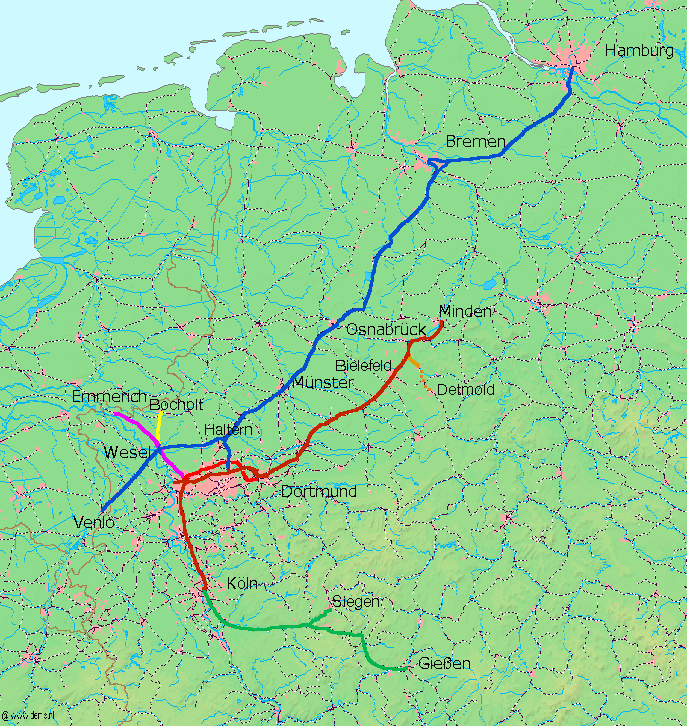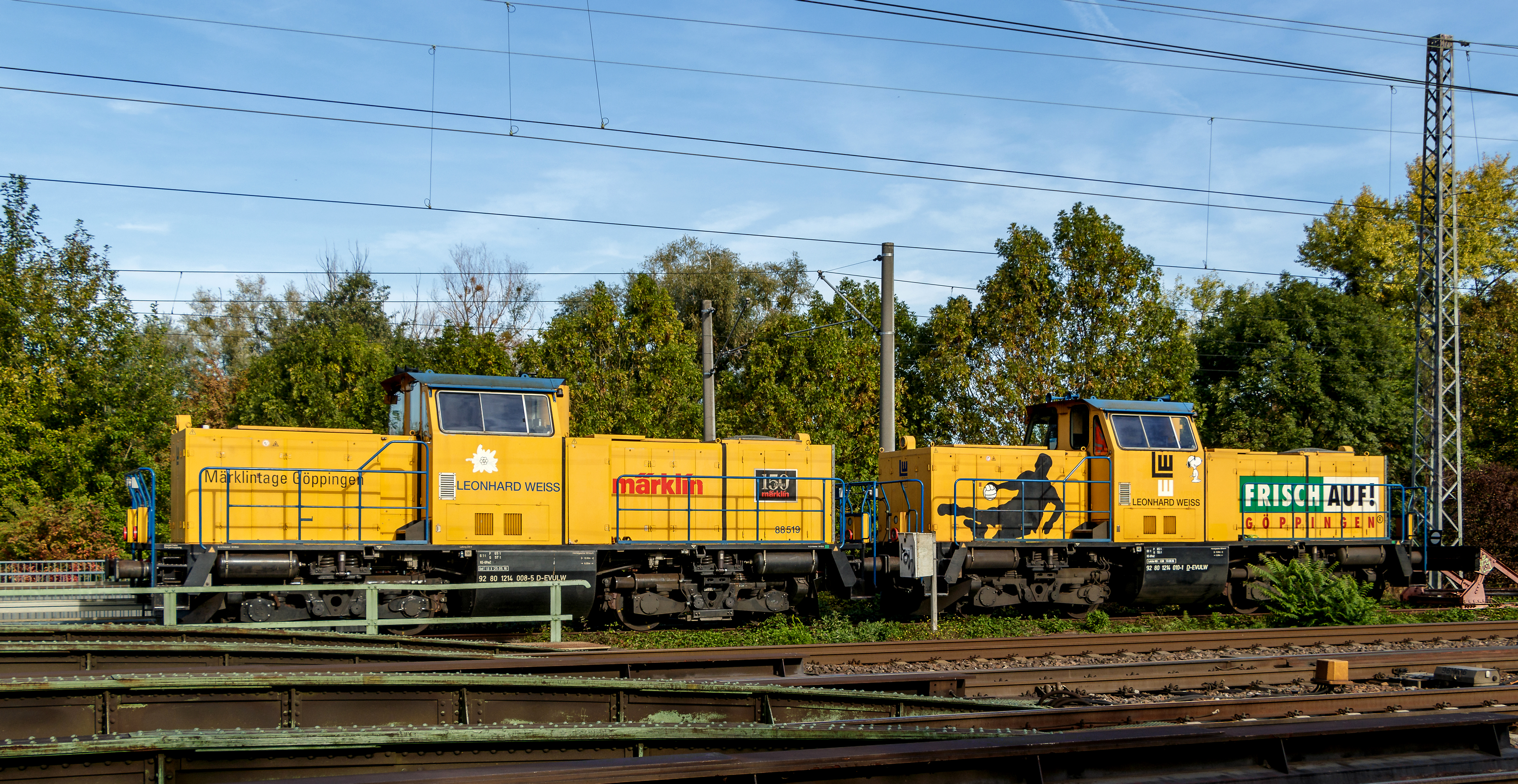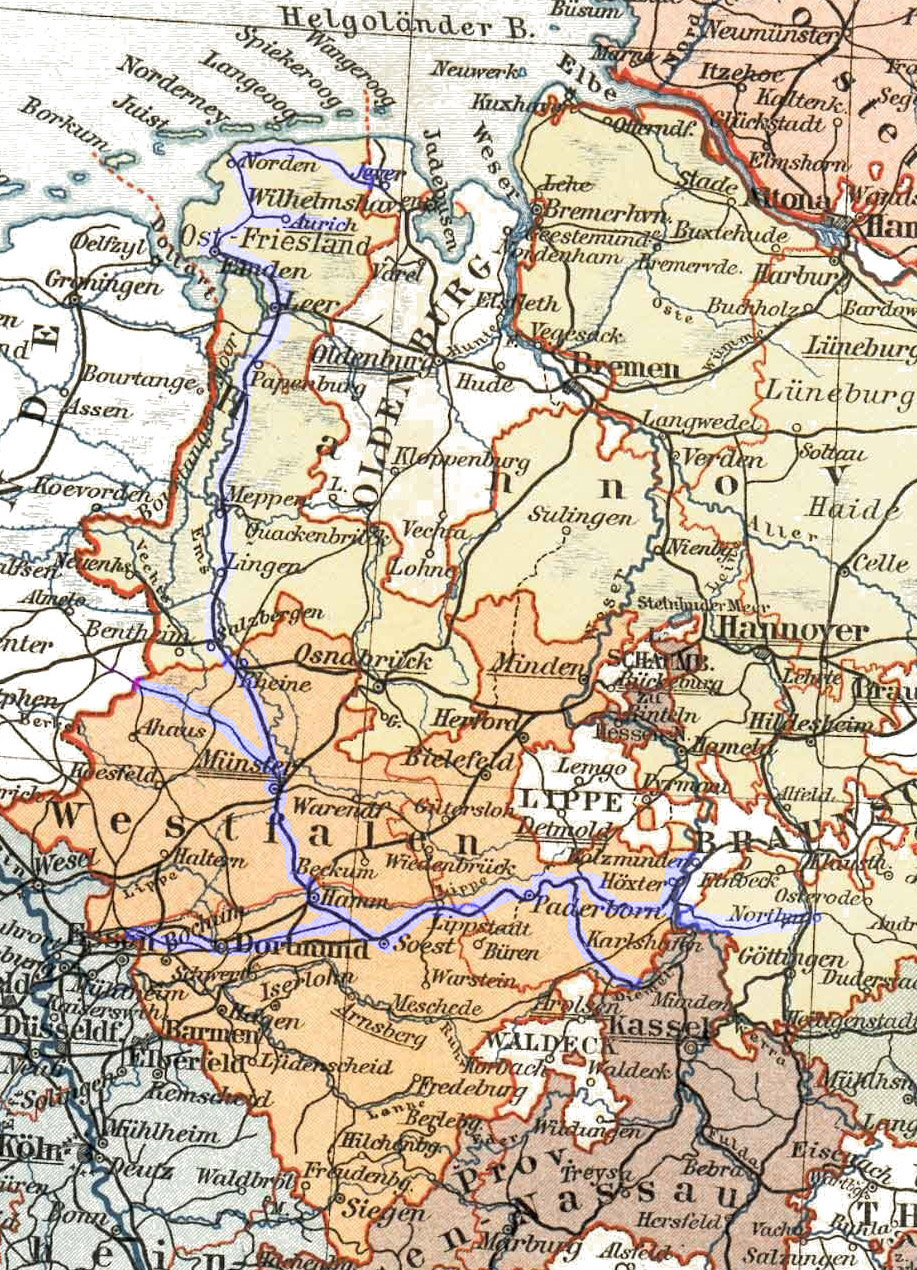|
Dortmund-Dorstfeld Station
Dortmund-Dorstfeld is an S-Bahn station in Dortmund in the German state of North Rhine-Westphalia. It the second most important S-Bahn node in the city after Dortmund Hauptbahnhof. It has four above-ground tracks, which are accessible via two island platforms and two underground tracks that are accessible via side platforms. The station is classified as a category 3 station. It is served by Rhine-Ruhr S-Bahn lines S1, S2 and S4. Significance The station is served by three lines of the Rhine-Ruhr S-Bahn, the S1 from Dortmund to Solingen, the S2 from Dortmund to Herne (and continuing to Recklinghausen or Essen) and the S4 from Dortmund-Lütgendortmund to Unna. All three lines are operated by DB Regio NRW and run at 30-minute intervals (15-minute intervals in the peak on the section through Dortmund-Dorstfeld). The station is a railway junction and is particularly important because line S4 uses an historic route (the Welver–Sterkrade railway, which was built by the Royal We ... [...More Info...] [...Related Items...] OR: [Wikipedia] [Google] [Baidu] |
Dortmund
Dortmund (; Westphalian nds, Düörpm ; la, Tremonia) is the third-largest city in North Rhine-Westphalia after Cologne and Düsseldorf, and the eighth-largest city of Germany, with a population of 588,250 inhabitants as of 2021. It is the largest city (by area and population) of the Ruhr, Germany's largest urban area with some 5.1 million inhabitants, as well as the largest city of Westphalia. On the Emscher and Ruhr rivers (tributaries of the Rhine), it lies in the Rhine-Ruhr Metropolitan Region and is considered the administrative, commercial, and cultural center of the eastern Ruhr. Dortmund is the second-largest city in the Low German dialect area after Hamburg. Founded around 882,Wikimedia Commons: First documentary reference to Dortmund-Bövinghausen from 882, contribution-list of the Werden Abbey (near Essen), North-Rhine-Westphalia, Germany Dortmund became an Imperial Free City. Throughout the 13th to 14th centuries, it was the "chief city" of the Rhine, Westphali ... [...More Info...] [...Related Items...] OR: [Wikipedia] [Google] [Baidu] |
Recklinghausen Hauptbahnhof
Recklinghausen Hauptbahnhof is a railway station for the city of Recklinghausen in Germany. History The original station opened in 1870 by the Cologne-Minden Railway Company as part of the construction of the Hamburg-Venlo railway. During the Second World War, on April 1, 1945, a heavy bombing raid mostly destroyed the station and tracks. It is commemorated by the bunker built next to the station, in which the Kunsthalle Recklinghausen was established in 1950. An outstanding feature of the architecture of the station building with its glass front is now the clock tower. The new bus station was built in 1998. Up until the renovation of the building, a plaque commemorating the 5000th kilometer of electrified rail of the Deutsche Bundesbahn, was located in the station. The plaque has been missing since the completion of the renovation. References Railway stations in North Rhine-Westphalia Hauptbahnhof Central stations or central railway stations emerged in the second half ... [...More Info...] [...Related Items...] OR: [Wikipedia] [Google] [Baidu] |
Deutsche Bundesbahn
The Deutsche Bundesbahn or DB (German Federal Railway) was formed as the state railway of the newly established Federal Republic of Germany (FRG) on 7 September 1949 as a successor of the Deutsche Reichsbahn-Gesellschaft (DRG). The DB remained the state railway of West Germany until after German reunification, when it was merged with the former East German Deutsche Reichsbahn (DR) to form Deutsche Bahn, which came into existence on 1 January 1994. Background After World War II, each of the military governments of the Allied Occupation Zones in Germany were ''de facto'' in charge of the German railways in their respective territories. On 10 October 1946, the railways in the British and American occupation zones formed the ''Deutsche Reichsbahn im Vereinigten Wirtschaftsgebiet'' (German Imperial Railway in the united economic area), while on 25 June 1947, the provinces under French occupation formed the Südwestdeutsche Eisenbahn. With the formation of the FRG these succe ... [...More Info...] [...Related Items...] OR: [Wikipedia] [Google] [Baidu] |
Cologne-Minden Railway Company
The Cologne-Minden Railway Company (German, old spelling: ''Cöln-Mindener Eisenbahn-Gesellschaft'', ''CME'') was along with the Bergisch-Märkische Railway Company and the Rhenish Railway Company one of the railway companies that in the mid-19th century built the first railways in the Ruhr and large parts of today's North Rhine-Westphalia. Founding The founding of the Cologne-Minden Railway Company in 1843 in Cologne ended a long struggle for a railway line between the Rhineland and the German North Sea ports, as well as the Prussian capital of Berlin. From the 1830s several railway committees in the cities of Düsseldorf, Cologne and Aachen attempted to find a solution with each other and the Prussian government. The focus of all these efforts was to avoid the Dutch duties on trade on the Rhine, which significantly increased the cost of import and export of goods via the Rhine. Some of the Cologne committee members under David Hansemann (1790–1864)—a merchant and banker fr ... [...More Info...] [...Related Items...] OR: [Wikipedia] [Google] [Baidu] |
Silberling
Silberling is the colloquial name for the n-coaches of the Deutsche Bundesbahn, a type of regional Passenger car (rail), passenger coach of which more than 5,000 units were built from 1958 to 1981. Nearly all of the coaches have undergone extensive modernisation – these modernised units are widely known as ''Mintling'', ''Grünling'' ("greenling") or ''Rotling'' ("redling") after their exterior colours. The term ''Buntling'' ("colourfulling") is used to denote refurbished Silberling coaches in general. Origin of the name The term ''Silberling'' derives from the coaches' stainless steel body which gave them a unique look during their term of service. Translated it means "silverling" in the English language. Historically, Silberling is a silver coin and widely known from the bible: the thirty pieces of silver (in the Bible translations into German, German Bible: "30 Silberlinge", Gospel of Matthew, Matthew 26,14) Judas Iscariot, Judas obtained for his treason. Technical data ... [...More Info...] [...Related Items...] OR: [Wikipedia] [Google] [Baidu] |
DB Class V 100
These DB Class V 100 diesel locomotives were produced in the late 1950s by the Deutsche Bundesbahn for non-electrified branch lines as a replacement for steam locomotives. The V 100 class was built in three different variants. Decommissioned locomotives were also used in Austria by the Austrian Federal Railways during the 1990s and early 2000s, where they were registered as ÖBB Class 2048 Class V 100.10 / Class 211 The Class V 100.10 was a diesel locomotive for light passenger and goods traffic on branch lines. It was developed in 1956 by the Bundesbahn Central Office in Munich together with the engineering works, Maschinenbau Kiel (MaK), for the Deutsche Bundesbahn. In the late autumn of 1958 the first six trials engines were delivered. Numbers V 100 001 to 005 were fitted with an 809 kW (1,100 HP) motor, but number V 100 006 was given a 993 kW (1,350 HP) motor. The latter formed the basis for the V 100.20, later DB Class 212. Number V 100 007 was built by MaK as t ... [...More Info...] [...Related Items...] OR: [Wikipedia] [Google] [Baidu] |
Technical University Of Dortmund
TU Dortmund University (german: Technische Universität Dortmund) is a technical university in Dortmund, North Rhine-Westphalia, Germany with over 35,000 students, and over 6,000 staff including 300 professors, offering around 80 Bachelor's and master's degree programs. It is situated in the Ruhr area, the fourth largest urban area in Europe. The university is highly ranked in terms of its research performance in the areas of physics, electrical engineering, chemistry and economics. The university pioneered the Internet in Germany, and contributed to machine learning (in particular, to support-vector machines, and RapidMiner). History The University of Dortmund (German: ''Universität Dortmund'') was founded in 1968, during the decline of the coal and steel industry in the Ruhr region. Its establishment was seen as an important move in the economic change (''Strukturwandel'') from heavy industry to technology. The university's main areas of research are the natural sciences ... [...More Info...] [...Related Items...] OR: [Wikipedia] [Google] [Baidu] |
Bergisch-Märkische Railway Company
The Bergisch-Markisch Railway Company (german: Bergisch-Märkische Eisenbahn-Gesellschaft, BME), also referred to as the Berg-Mark Railway Company or, more rarely, as the Bergisch-Markische Railway Company, was a German railway company that together with the Cologne-Minden Railway (''Cöln-Mindener Eisenbahn-Gesellschaft'', ''CME'') and the Rhenish Railway Company (''Rheinische Eisenbahn-Gesellschaft'', ''RhE'') was one of the three (nominally) private railway companies that in the mid-19th century built the first railways in the Ruhr and large parts of today's North Rhine-Westphalia. Its name refers to Bergisches Land and the County of Mark. History Foundation The Bergisch-Markisch Railway Company was founded on 18 October 1843 in Elberfeld (Today Wuppertal). Since the Cologne-Minden Railway Company had decided to build its route via Duisburg rather than through the valley of the Wupper river, the Bergisch-Markisch Railway Company (german: Bergisch-Märkische Eisenbahn-Gesellscha ... [...More Info...] [...Related Items...] OR: [Wikipedia] [Google] [Baidu] |
Bochum Hauptbahnhof
Bochum Hauptbahnhof is a railway station for the city of Bochum in western Germany. In its current incarnation, it was built from 1955 to 1957 and is one of the most notable 1950s railway stations in Germany. The station underwent extensive remodeling and modernisation from 2004 to 2006 and was officially reopened on 29 May 2006. History The old station was opened in 1860 as the Bochum station of the Bergisch-Märkische Railway Company as part of its Witten/Dortmund–Oberhausen/Duisburg railway opened between 1860 and 1862, which was the first line built through the city of Bochum. It was located on the south-western edge of the historic centre, in the northern part of the emerging city of Bochum-Ehrenfeld, and was well-located near the important heavy industries such as the steel mills of Bochumer Verein and various collieries. Access to the station for passengers was not ideal and the space was inadequate for the increasing volume of traffic and was constrained by the construc ... [...More Info...] [...Related Items...] OR: [Wikipedia] [Google] [Baidu] |
Royal Westphalian Railway Company
The Royal Westphalian Railway (german: Königlich-Westfälische Eisenbahn, KWE) was a German rail company established in 1848 with funding from the Prussian government, which later became part of the Prussian State Railways. The network eventually extended about 315 km from Rheine via Hamm to Warburg and from Welver (near Hamm) to Oberhausen. History The ''Royal Westphalian Railway'' was initially established only to fill the 32 km-long gap between Hamm and Lippstadt, connecting the Münster–Hamm line of the ''Munster–Hamm Railway Company'' (''Münster-Hammer Eisenbahn-Gesellschaft'') opened in 1848 with the line being constructed at the same time by the ''Cologne-Minden-Thuringian Connection Railway Company'' (''Köln-Minden-Thüringischen-Verbindungs-Eisenbahn-Gesellschaft'', KMTVEG). The latter company, however, went bankrupt in 1848 and further construction and the line's later operations were taken over by the Prussian government. The cause of the bankruptcy ... [...More Info...] [...Related Items...] OR: [Wikipedia] [Google] [Baidu] |








